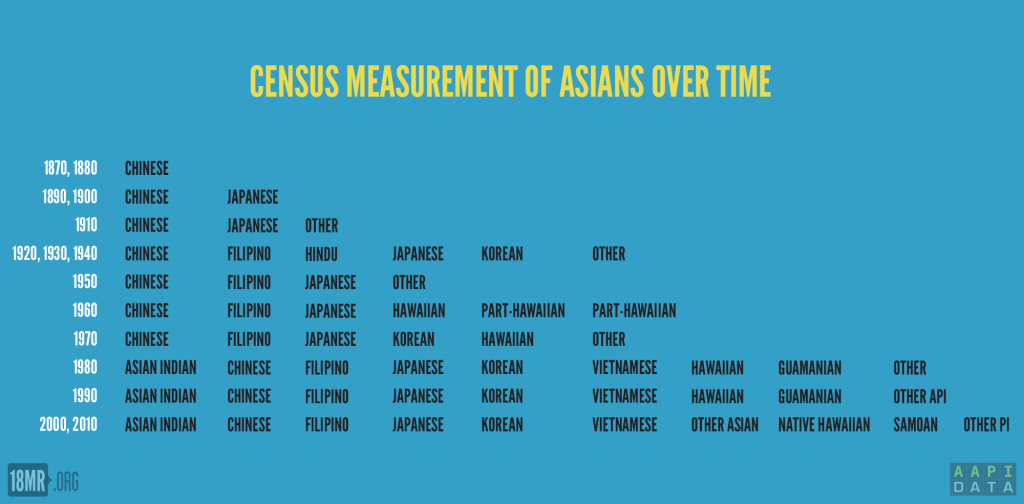AAPI Voices is a new platform launched for Asian Pacific American Heritage Month to develop and feature data-inspired writing and provocative short pieces relating to AAPI communities and AAPI experiences. The post below is an excerpt shared by permission of the writer and AAPI Voices. It connects to one of the themes being explored by AAPI Voices — Are AAPIs “One, Two, or Many?” on issues like evolving racial, ethnic and cultural categorizations.

I was born and raised in L.A., but the boundaries of South Asian geography have defined me as far back as [pullquote align=”right”]My brown skin and “complicated” name made it challenging for my teachers to put me in a box.[/pullquote]I can remember. Could it have been otherwise? My brown skin and “complicated” name made it challenging for my teachers to put me in a box. (Moving to a new school every year for much of my youth didn’t really help either.) After mangling my name, they would inevitably say, “That’s so pretty! You must be Indian…” with a knowing intonation.
I didn’t know what I was really, but despite my young age, this forced me to try to figure it out. The first time I was told this, when I got home, I asked my mom if we were Indian. She was offended: “Khee bholo, we are from Bangladesh. It’s a separate country. Stupid Americans!”
To my teachers, I learned quickly that I had to explain that actually, my family was from “that small country to the east of India” — to explain how yes, it was once known as East Pakistan, and yes, it did technically used to be India before that, when the land of South Asia was colonized by British East India Company and before that the Mughal Dynasty but, yes, in contemporary history India was partitioned in 1947, and then in 1971, Bangladesh broke off from Pakistan to be its own nation-state. And no, it doesn’t mean it’s basically the same thing anyway — or that it’s okay to confuse any of the three.
All of this was happening when I was just eight years old.
It took me a lot longer to understand that this was how race is placed on us. That this childhood microaggression, being questioned and second-guessed by teachers for allegedly not knowing what I was, was a symptom of being categorized — of being racialized. When I was at home with my family, I could easily answer who I was. When I was outside, adrift and floating in the mainstream, I couldn’t.
To be fair to my teachers, nation-state identification is an artificial proxy as an ethnic identifier. [pullquote align=”right”]In the context of this colonized history, “South Asian” identity is a real thing.[/pullquote] The border regions of South Asia are rich with stories of families getting split as people found themselves divided by sudden new boundaries. My grandfather went to college in Calcutta before he was partitioned into Bangladesh. My mother was raised in Pakistan before the Independence War forced her back to Bangladesh. A few years later, marriage brought her to California. My dad still has the Pakistani passport from 1968 that he replaced with a Bangladeshi one in 1972. In the context of this colonized history, “South Asian” identity is a real thing.
But South Asian identity in America is another thing entirely, with its own set of complications. By the time I was an adult, I came to realize that my experience was hardly unique: South Asians have never quite known how to define ourselves in in this country.
Read the rest of “Not Just ‘Asian Indian'” by Tanzila “Taz” Ahmed at AAPI Voices.
* * *
Tanzila “Taz” Ahmed is an activist, storyteller, and politico based in Los Angeles currently working as the Voter Engagement Manager at Asian Americans Advancing Justice – Los Angeles. She was a long-time writer for Sepia Mutiny, and was recently published in the anthology and currently writes a monthly column called Radical Love. Her personal projects include curating images for Mutinous Mind State, writing about Brown music at Mishthi Music where she just co-produced Beats for Bangladesh: A Benefit Album in Solidarity with the Garment Workers of Rana Plaza and making #MuslimVDay Cards. Taz also organizes with Bay Area Solidarity Summer and South Asians for Justice – Los Angeles. You can find her rant at @tazzystar and at tazzystar.blogspot.com.












